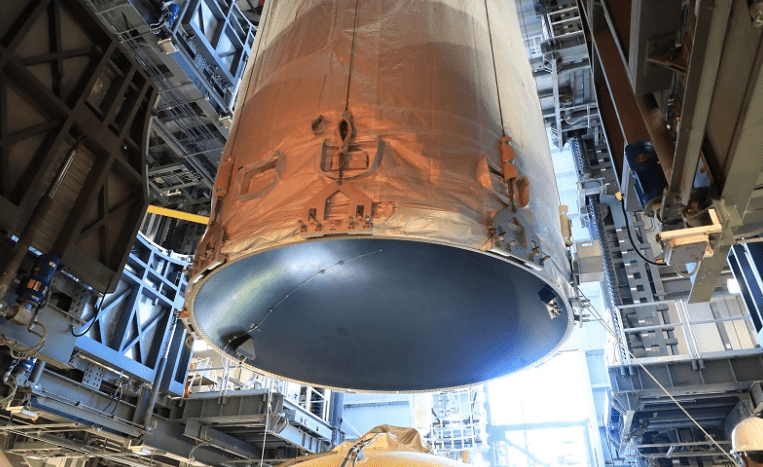Latest News

ULA said that it has fitted the NROL-44 payload onto a Delta IV heavy rocket to be launched on Aug. 26. Photo: ULA
United Launch Alliance (ULA) is preparing a Delta IV Heavy rocket with a classified National Reconnaissance Office (NRO) payload, NROL-44, for launch at Cape Canaveral Air Force Station, Florida, on Aug. 26.
Launch preparations for NROL-44 began last year, and the classified payload arrived and was mounted on the rocket at Space Launch Complex-37 (SLC-37) at Cape Canaveral on July 27. “Technicians used the gantry crane to lift the payload through the hoistway on the Mobile Service Tower (MST) and position it for connection to the Delta Cryogenic Second Stage (DCSS),” per ULA. “The fully assembled Delta IV Heavy rocket stands 235 ft tall and will weigh 1.6 million lbs once fueled during the countdown to liftoff.”
The final preparations come on the heels of ULA’s Aug. 7 win in Phase 2 of the U.S. Air Force’s launch service procurement (LSP) program for National Security Space Launch (NSSL). ULA received a $337 million contract for two classified launches, and SpaceX received a $316 million contract for one classified launch. ULA and SpaceX may receive contracts for 34 launches under Phase 2. Under the terms of the agreement, ULA is to receive 60% of the launches, while SpaceX is to receive 40%. That could mean that ULA would receive 20 launches and SpaceX 14.
Marco Cáceres, a senior space analyst with the Teal Group, said that the pressure is now on ULA to ensure its Vulcan rocket performs well and reusably in Phase 2 to reduce costs significantly below $400 million per launch.
SpaceX has targeted Falcon Heavy to cost no more than $150 million per launch. Cáceres noted SpaceX’s successes since 2018 in breaking into the military space launch business with Falcon Heavy, its continued Falcon commercial launches, and the success of SpaceX’s Crew Dragon NASA spacecraft, which splashed down in the Gulf of Mexico on Aug. 2 after a two-month voyage that was NASA’s first crewed mission from the U.S. in nine years.
ULA’s Delta IV Heavy is the sole remaining Delta rocket after the retirement of the Delta IV Medium last year and the Delta II in 2018. The Delta IV Heavy rocket “serves the nation’s high-priority U.S. Space Force and National Reconnaissance Office space programs with distinction as America’s proven heavy-lifter,” Tony Taliancich, ULA’s launch operations director and general manager, said in a statement.
The U.S. Air Force has said it would determine when to shut off Launch Services Agreement (LSA) funding for Northrop Grumman and Blue Origin, the two companies that lost out in Phase 2 of LSP. Air Force acquisition chief Will Roper told reporters on Aug. 10 that the Air Force “will tie off the LSA contracts just as soon as we can at a point that makes sense.”
In 2018, the Air Force awarded LSA contracts to Blue Origin–$500 million for developing its New Glenn space launch vehicle, $792 million to Northrop Grumman to develop its OmegA rocket, and ULA $967 million to develop the Vulcan rocket. SpaceX did not receive any funding and sued in federal court in California. That case is ongoing, and the Department of Justice’s civil division is handling the government response.
Given SpaceX’s success in becoming a prominent military launch provider since 2018, Cáceres said that he expects that Elon Musk, the founder of SpaceX, will either drop the lawsuit or settle it.
Northrop Grumman said that it looked forward to a government debriefing on why the company did not receive a Phase 2 LSP award, while Blue Origin said that, while disappointed, the company will retain a stake in Phase 2, as Blue Origin’s BE-4 engine will power ULA’s Vulcan launch vehicle.
SpaceX has issued no response to its Phase 2 win, nor has Musk.
The NSSL effort is to allow the Air Force to end reliance on the Russian-made RD-180 engine by leveraging U.S. commercial launch capabilities. The service has 12 RD-180 engines it can use, if a catastrophic failure arises in the NSSL program, but the service is prohibited by law from buying new RD-180s after 2022.
Roper has said that the Air Force could only afford to award contracts to two launch providers for future national security space launches, after a government-sponsored study largely agreed with that assessment.
This article was originally published by our sister publication Defense Daily.
Get the latest Via Satellite news!
Subscribe Now